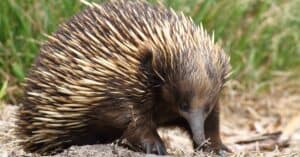
The duck-billed
platypus
is the most well-known mammal that can lay eggs.
©Martin Pelanek/Shutterstock.com
Mammals are defined as warm-blooded vertebrates that have hair or fur, provide milk to their offspring, and typically give birth to live young. Giving birth to live young is widespread for both land and sea mammals, but a small group of mammals do not share this quality.
Several of these animals are critically endangered and one is practically extinct. Let’s dig into these five unique mammals to understand why they lay eggs and where they live.
What Mammals Lay Eggs?
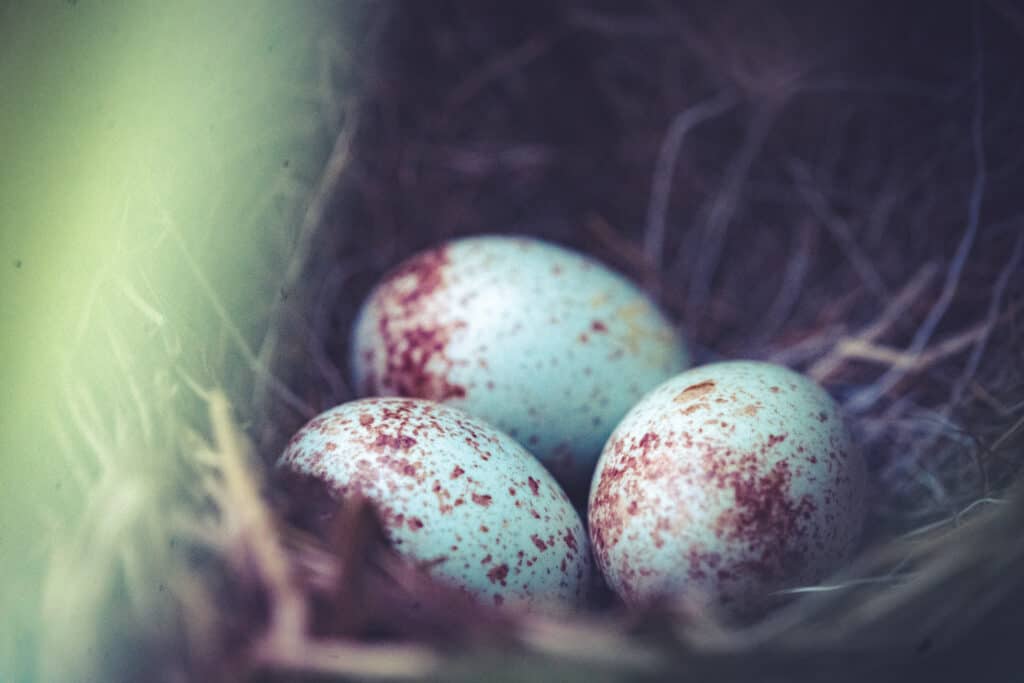
Birds, reptiles, and monotremes build nests or dig burrows for their eggs to camouflage them.
©Adeline Weyland/Shutterstock.com
While the majority of mammals give birth to live young, a select group of mammals lay eggs.
Monotremes are mammals that lay eggs. In Greek, this term translates to “one opening” which refers to the single duct (cloaca) the animal uses to urinate, defecate, and reproduce. This specific trait is common in reptiles and birds.
How Mammals Are Able to Lay Eggs
Scientists theorize these mammals have a common ancestor which gave them the specific trait of laying eggs. Amniotes are animals whose embryo develops inside an egg without the need for water. Snakes and birds possess this dominant gene, allowing them to reproduce with eggs.
5 Mammals That Lay Eggs
The five mammals that lay eggs are the duck-billed platypus and four related species of echidna. Each animal lives in a small section of the world and the echidnas share many similar traits like diet, defense mechanisms, and conservation status.
Duck-Billed Platypus

Platypuses love eating worms that they spend hours digging for in the mud.
©John Carnemolla/Shutterstock.com
The duck-billed platypus is infamous for being one of the strangest creatures on Earth. Its unusual features create a real-life chimera (an animal made up of parts from several different animals). A duck-billed platypus looks like a beaver, a duck, and a snake, all rolled into one animal!
Interestingly, platypuses are venomous (thus the snake portion). They have a small claw at the edge of their webbed feet which can inject a venomous toxin into predators. The venom is excruciatingly painful to humans and deadly to small mammals. Thankfully, the venom is non-lethal to humans.
Platypus Reproduction
A female platypus reaches maturity at two years old and lays a clutch of one to three eggs at a time. Baby platypus (puggles) stay with the mother, living in a protective pouch on her body for several weeks. As they age, the babies are moved to a small burrow along the shore. When the puggles are four or five months old, they start swimming and foraging on their own.
Platypus Diet
The platypus consumes a diet of worms, fish, and insect larvae. They swim to the bottom of the river or lake, digging around in the mud to find food. They grab what they can with their bills and bring it up to the surface where they can eat it without ingesting water. When puggles are hiding in a burrow, the mother platypus carries food to them, before teaching them how to hunt.
Platypus Habitat
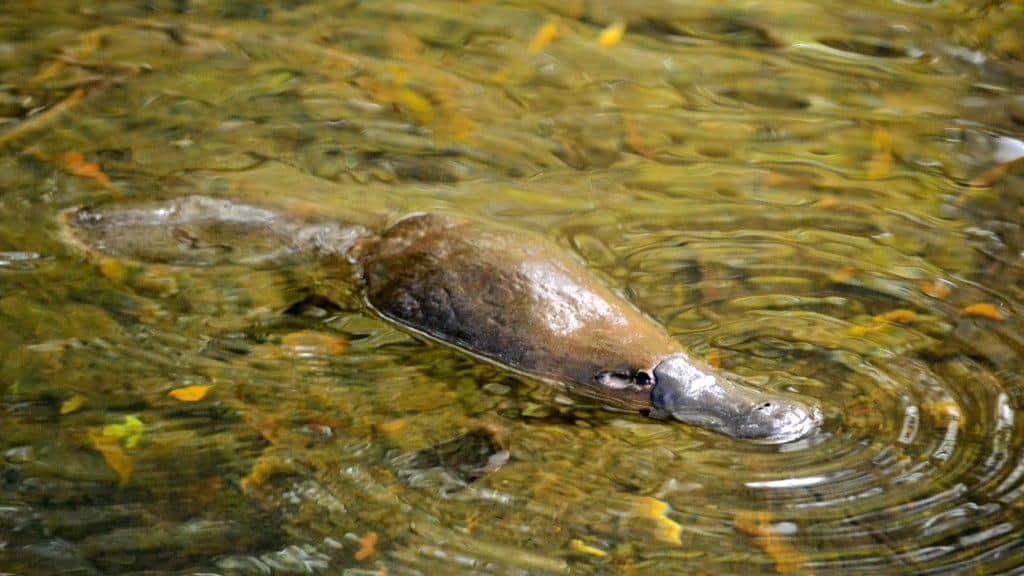
The only platypuses that live in North America reside in the San Diego Zoo.
©Klaus / Flickr – Original
Duck-billed platypus only live in rivers in Eastern Australia along the Great Dividing Range. These animals are exceptionally rare, and they cannot be found anywhere else in the world.
Scientists theorize that the platypus adapted to living in the water when marsupials migrated to the region 71 million to 54 million years ago. Because platypuses were easy prey for large predators, they sought shelter in water and burrows.
Platypus Conservation Status
Because of their limited habitat, they are “near threatened.” They are protected by Australian legislation against poaching, but the animals are still hunted by predatory animals. Habitat loss from agriculture and logging reduces their already restrictive habitat.
Western Long-Beak Echidna
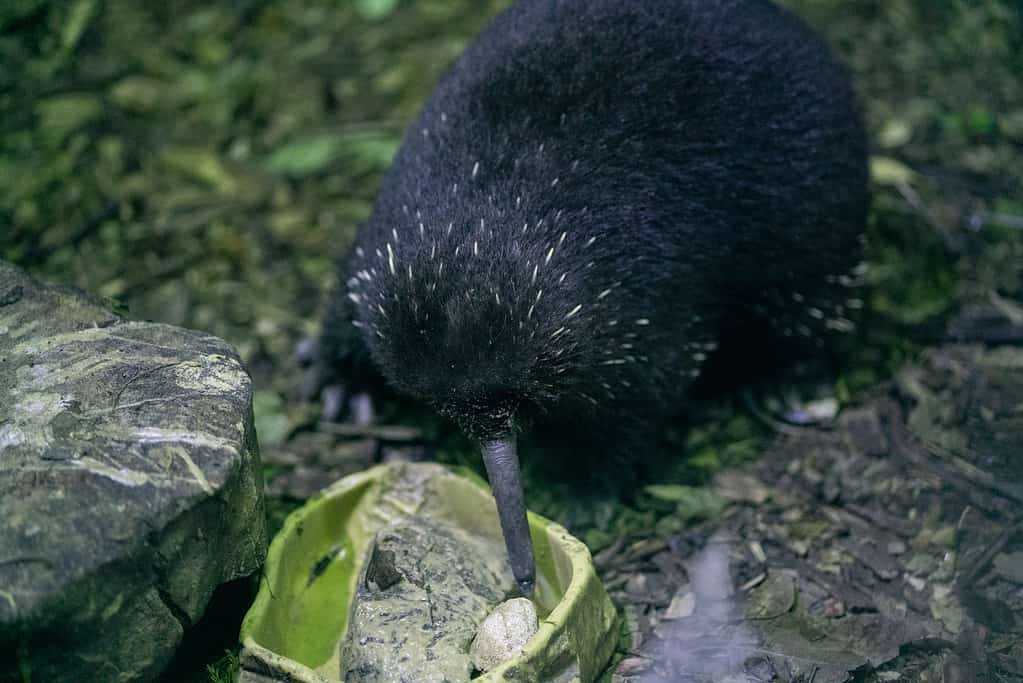
Western long-beaked echidnas have long snouts they use to sniff out worms under the soil.
©Julien Viry/iStock via Getty Images
The western long-beak echidna is one of four echidnas that make up the remaining egg-laying mammals. It is the largest monotreme in the world, weighing 40 pounds. Their name is a direct description of the animal itself, being an echidna with a long beak, and living in the western highland forests of Australia, New Guinea, and Tasmania.
Western Echidna Reproduction
Unlike the platypus, the western echidna only lays one egg. The egg hatches in 10 days, after which, the mother carries the young pup in her pouch for protection.
After several weeks of carrying the infant, the mother digs a deep burrow with her strong paws and places the infant there while she forages for food.
Western Echidna Diet
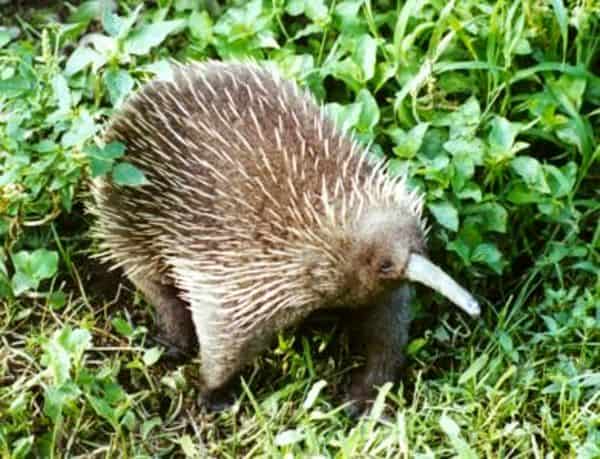
Echidnas are critically endangered, and sightings are very rare.
©User: Jaganath, CC BY-SA 3.0, via Wikimedia Commons – Original / License
Echidnas are insectivores, eating assorted insects and insect larvae. However, their primary diet consists of earthworms and grubs. By using their long snout, they sniff out worms, insects, and grubs in the ground or under logs. Then, they use their snouts to lick up tasty morsels. Western echidnas spend most of their day foraging for food.
Echidnas are also called “spiny anteaters” because of their similar shape, long noses, and similar diet. The difference is that anteaters are much larger and have hair, while echidnas have spines to protect them from predators.
Western Echidna Conservation
Western echidnas are critically endangered due to habitat loss from mining, agriculture, and logging. Feral dogs and other predators hunt echidnas as an easy meal, reducing their numbers further. Additionally, they only reproduce one egg at a time, making them a high-risk species for extinction.
Eastern Long-Beak Echidna
The eastern echidna is nearly identical to its western counterpart.
Eastern and western echidnas both:
- Have the same diet
- Reproduce only one offspring at a time
- Care for the young directly in their pouch and, later, in a burrow
- Live in the highlands of Australia and New Guinea
- Are hunted by feral dogs and other predators
However, the eastern echidna has a conservation status of “vulnerable,” meaning there are more of them roaming the lands. The species still requires dedicated efforts to protect their land, as their population is steadily decreasing.
Short-Beaked Echidna
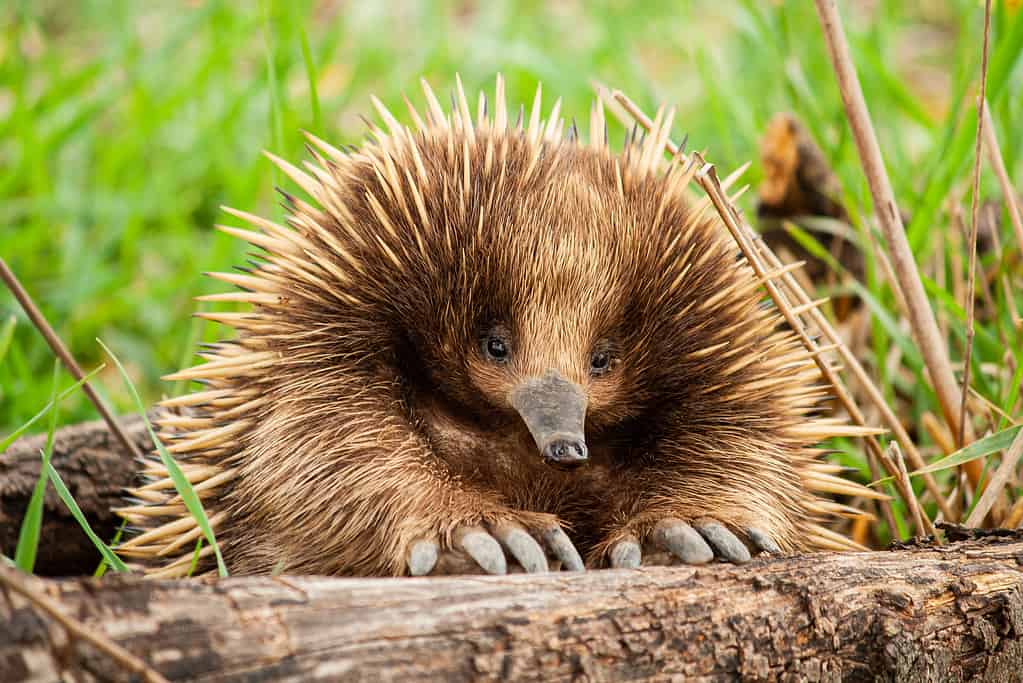
Echidna are easy to identify thanks to their simple naming conventions of beak size and animal name.
©Jarrod Calati/iStock via Getty Images
The third echidna and fourth monotreme is the short-beaked echidna. This little critter is affectionately called the spiny anteater because it is a delightful combination of an anteater and a hedgehog, with an echidna’s body.
The short echidna has sharp quills that lay flat against its body when relaxed. However, when threatened, they point up to prevent predators from attacking. When threatened, they curl up into a ball to protect their soft underbelly.
Short Echidna Reproduction
The short echidna mom lays a single egg, watching it carefully until it hatches within a few days. The mother carries the infant in her pouch for seven weeks, before moving it to a nearby burrow. Infants are born without quills, making it safe for the mother to carry them in her pouch. When the quills start coming in within a few weeks, she moves her young to prevent accidental poking. After six months of tending to her child, the young echidna will leave the burrow and fend for itself.
Short Echidna Diet
Like other echidnas, the short echidna is an insectivore, finding protein in worms and other insects. However, the short echidna also uses its long and sticky tongue to slurp ants and termites from their mounds like an anteater.
Their heightened sense of smell allows them to find anthills, termite mounds, and insects buried in the ground. It also helps them discover predators in the area.
Short Echidna Habitat

Their quills replenish themselves every few weeks to ensure the echidna is always protected.
©pelooyen/iStock via Getty Images
The short echidna is found across Australia, Tasmania, and parts of New Guinea. Being spread out across the islands gives them more space to roam and reproduce. They love living in heavy forest areas with plenty of termite mounds available, as well as grasslands and outer suburbs.
Short Echidna Conservation
Short echidnas are currently a “least concern” species, but every year their population decreases due to habitat loss, predators, and parasites.
Sir David’s Long-Beaked Echidna

The only evidence that Cyclops echidna is not extinct are small nose marks in the ground.
©Rene Preimesser/iStock via Getty Images
Finally, Sir David’s long-beaked echidna is the most elusive and possibly extinct monotreme. It is also called the Cyclops long-beaked echidna.
Sir Attenborough did not discover the species. It was an honorary title for his work in biology and his great achievements in his dedication to research, documentation, and advocacy for nature restoration and protection.
Unfortunately, there is extraordinarily little information on this species because it is considered one of the “most wanted species” for wildlife conservation. They are critically endangered from hunting and habitat loss, and they were considered extinct for many years.
Recently, scientists found evidence of unique nose prints in the ground that match the anatomy of the Cyclops echidna, giving hope the species is still alive.
The little information available on the species includes:
- They live in the Cyclops Mountains in Papua, New Guinea.
- This echidna species eats earthworms, grubs, termites, ants, and larvae.
- They are nocturnal.
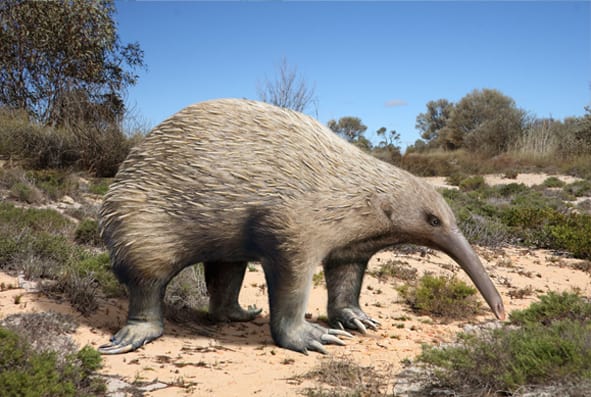
is an extinct species similar to the ones remaining.
The small niche of mammals capable of laying eggs is fascinating! Unfortunately, they are possibly going extinct. Several of these animals are critically endangered, with one being possibly extinct already. It will take a lot of effort to ensure these animals are safe and protected for future generations.
Thank you for reading! Have some feedback for us? Contact the AZ Animals editorial team.





